Meridian Pointers to North
Meridian pointers to north are pairs of stars that cross the meridian together and point down to North on the horizon. In the diagram below, Manōkalanipō (Alpheratz, in the Great Square of Pegasus) and Polo‘ula (Caph in ‘Iwakeli‘i, or Cassiopeia) align on the meridian, which intersects the horizon line perpendicularly at North, after passing through the North Celestial Pole (NCP).
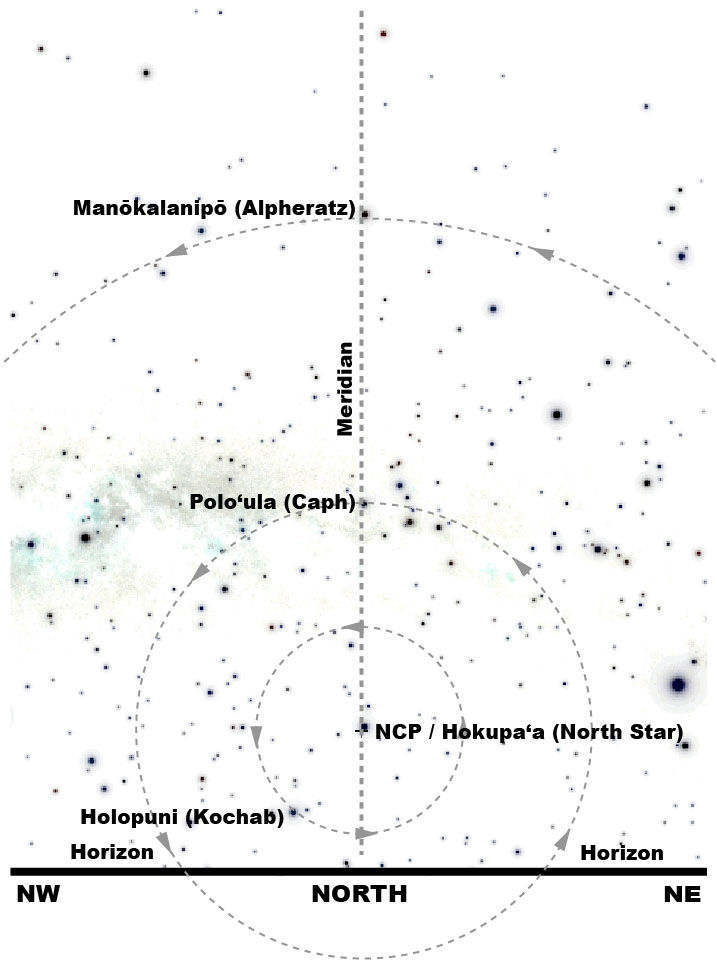
The meridian (dotted line perpendicular to the horizon) is an imaginary line from the North Celestial Pole (NCP) to the South Celestial Pole (SCP), passing through the Zenith, the point in the sky directly overhead and intersecting the horizon perpendicularly at due North and due South.
Because of the earth’s 24-hour rotation, the sky appears to be rotating around the NCP, counter-clockwise, from right to left, returning to its starting point every 24 hours; stars cross the meridian during this rotation.
Because Honolulu is at 21 N latitude, the North Celestial Pole (NCP) is 21 degrees above the horizon. Hokupa‘a, the North Star, appears less than a degree away from the NCP. The distance of the NCP above the horizon is equivalent to the latitude of the observer north of the equator. (See “The Celestial Sphere” for an explanation of this phenomenon. Hawai‘i is situated between the latitudes of 19° N and 22°N, with its midpoint at 20.5° N.)
Because the NCP is 21 degrees above the horizon, stars within 21 degrees of the NCP (e.g. Holopuni, or Kochab, in the chart above) are circumpolar, neither rising nor setting.
The night sky charts below depict the alignment of nine star meridian pointers to North. The sky is depicted without regard to night or day. In daylight or under cloudy conditions at night, you would not be able to see some or all of the sequence since the sky would be hidden by light or clouds, although the stars would be moving in this sequence whether you can see them or not. In different months and seasons of the year, different portions of the sequence are visible at night.
The numbers in parentheses after the star names below are Right Ascension (RA), given in hours (h) and minutes (m). RA gives one of two coordinates to fix the position of a star on the celestial sphere. (See “The Celestial Sphere.”) The closer the RA numbers are for two stars, the more closely they will align at the meridian. Two stars with the same RA will cross the meridian together.
You can calculate how long it will take a star to reach the meridian after another star by subtracting the RA of the second star from the RA of the first. Thus, Segin in Cassiopeia, with an RA of 01h 54.4m, will arrive at the meridian about an hour and 45 minutes after Polo‘ula (Caph in Cassiopeia), with an RA of 00h 9.2m.
For notes on Hawaiian star names, see Hawaiian Star Lines.
Nine Pairs of North Pointers
1. Polo‘ula (Caph) in ‘Iwakeli‘i (Cassiopeia) (00h 9.2m) and Alpheratz in Ka Lupe o Kawelo (in the Great Square of Pegasus) (00h 8.4m). Polo‘ula is the bottom star of the left stem in the configuration of ‘Iwakeli‘i (Cassiopeia) that looks like a wide M.
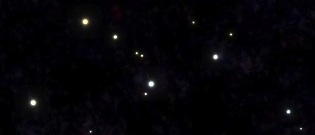
In the chart below, as M circles above Hokupa‘a (the North Star) and the NCP, and Polo‘ula crossing the meridian aligns with the star Alpheratz, the brightest star of Ka Lupe o Kawelo (the Great Square of Pegasus). (In the configuration of the Great Square above the NCP, the bottom right corner of the square is Alpheratz.) Higher up, near the top of the chart is Scheat, the star at the top right corner of the Great Square. The bright star to the right of the NCP, directly above NE, is Hokulei (Capella) which rose earlier between NE and NE by N.
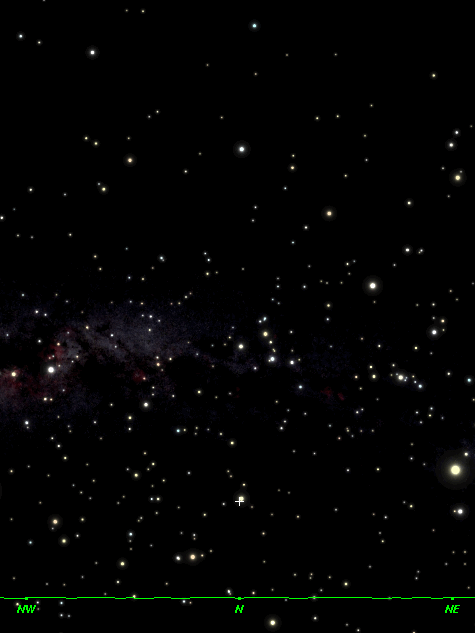
Note: For print versions of the night-sky charts that would use less toner (like the first chart at the top of this webpage), you can convert the dark sky chart with light stars to one with a white sky and dark stars by dragging the image onto your desktop and using the Invert function in a graphic program like Photoshop (Image>Adjustments>Invert) to reverse the image.
2. Segin in Cassiopeia (01h 54.4m) and Alpha Trianguli (01h 53.1 m). Less than two hours after Polo‘ula (Caph) crosses the meridian, the wide M of ‘Iwakeli‘i has rotated left, and the last star in the M (the bottom star of the right stem), the relatively faint Segin, is crossing the meridian. Above it is the bright star Almach in Pegasus, but a closer alignment on the meridian is with the relatively faint Alpha Trianguli, the apex of a tall triangle, leaning to the left, just above Almach.
In the chart below, Hokulei (Capella) has risen to an altitude higher than the NCP; directly above it, halfway between it and the top of the chart, is the cluster of stars called Makali‘i (Pleiades).
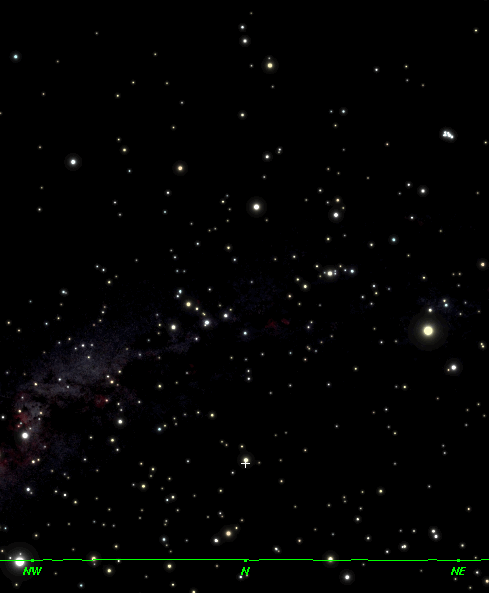
3. Menkalinan (05h 59.5m) and Theta Aurigae (05h 59.7m). Four hours after the pair Segin and Alpha Trianguli crosses the meridian, the next pair is crossing, two stars in the constellation Hokulei ("Wreath of Stars," Auriga, or Charioteer, in the West), which includes five bright stars forming a circle or pentagram. In the chart below, the brightest star in the lei, Hokulei (Capella) and the next brightest star, Elnath (near the top of the chart), have rotated to the left of the meridian and behind the (i.e., to the right) aligned above the NCP and N are Menkalinan and Theta Aurigae.

Meanwhile, Makali‘i (the Pleiades) have rotated to the west (left of the circle of Hokulei, near the border of the chart; to the right of the circle of Hokulei, are the two bright stars of Na Mahoe, the Twins (Gemini), which rose NE by E earlier. Directly below Na Mahoe is Na Hiku (Big Dipper) having risen completely above the horizon, the last star in the handle marking NE by N for the navigator.
4. Na Mahoe (The Twins): Nanamua (Castor) (07h 34.6 m) and Nanahope (Pollux) (07h 45.3 m); and Puana (Procyon) (07h 39.3m). An hour and a half after the pair Menkalinan and Theta Aurigae have crossed the meridian, the next alignment of north pointers arrive: Na Mahoe (Gemini is on the meridian and a line between the two stars goes up to the bright star Puana (Procyon), near the top of the chart. Na Hiku, the Big Dipper, has risen off the horizon and rotated hilgher than the NCP.
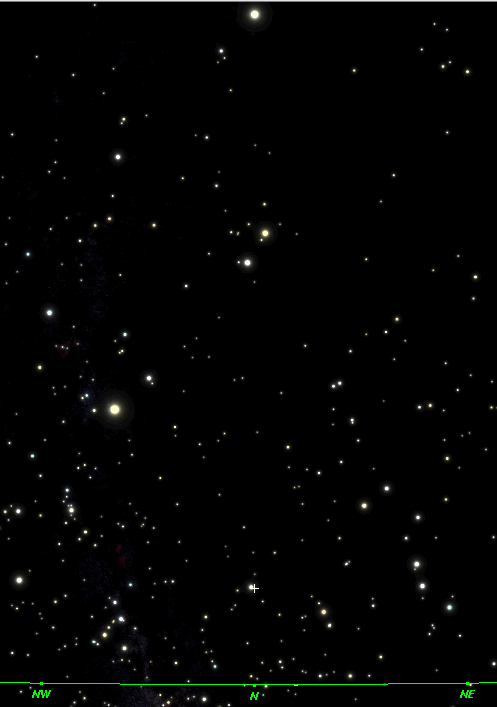
5. Hikukahi (Dubhe) (11h 3.7m) and Hikulua (Merak) (11h 1.8 m). Four hours after Na Mahoe is atthe meridian, the two front stars of Na Hiku (Big Dipper) are aligned directly above the NCP and N. The Little Dipper is extended out to the right of the NCP and Hokupa‘a (North Star).
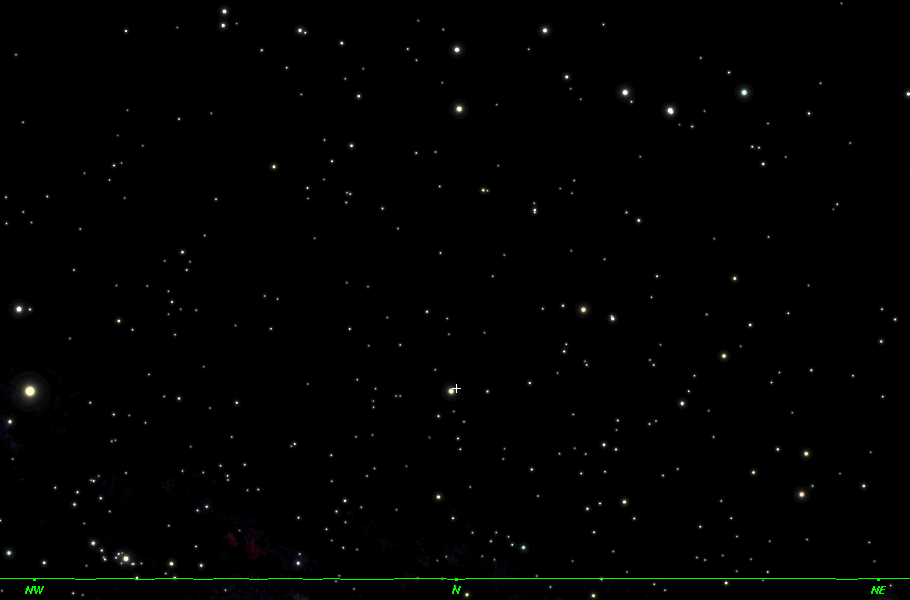
Note: This night sky charts and those below extending to the left and right margins of the text are larger than they appear in this html file. You can view the larger charts by dragging the images from the browser onto your desktop, then opening them with graphic-viewing software.
6. Hikulima (Alioth) (12h 54m) and Cor Caroli (12h 56m). Two hours after the two front stars of Na Hiku (Big Dipper) were at the meridian, Hikulima (Alioth), the first of three stars in the handle of the Dipper, aligned above the NCP and N with Cor Caroli, the brightest star at the apex of a a relatively dim triad of stars, near the top of the chart.
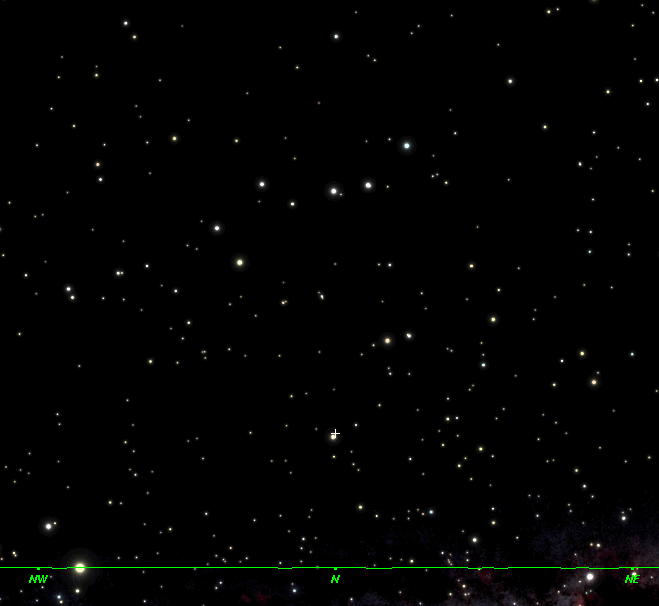
Just setting, at the border of NW and NW by N is Hokulei (Capella). And Pira‘etea (Deneb in Cygnus) is just below the horizon, set to rise at the border of NE and NE by N.
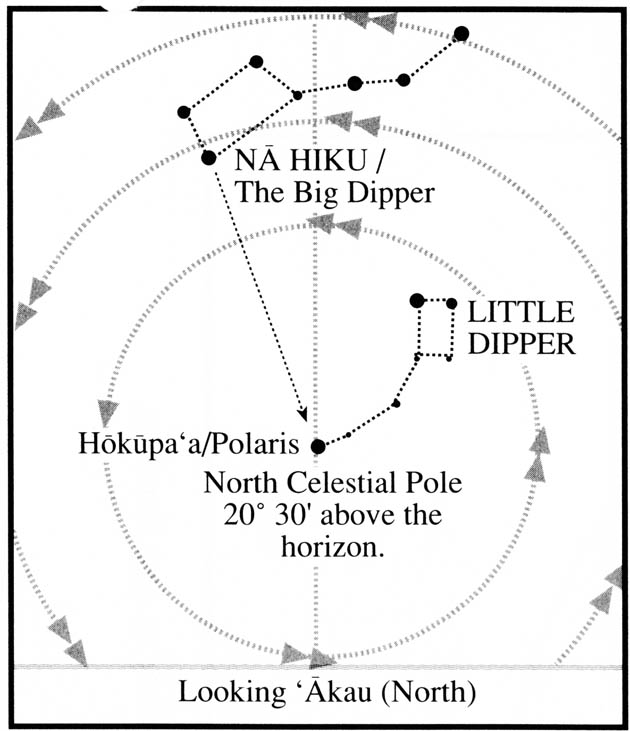
As Na Hiku rotates around Hokupa‘a and the NCP, it continues to point at them.
7. Pherkad (15h 20.7m) and Ed Asich (15h 24.9m). Three and a half hours after Hikulima (Alioth) and Cor Caroli are at the meridian, the next pair, Pherkad, in the Little Dipper, and Ed Asich, a dim but isolated star in the Constellation Draco are aligned directly above the NCP and N. The brighter star a little below and to the left of Pherkad is the brightest star in the Little Dipper, Holopuni (Kochab). Both stars are circumpolar in Hawai‘i (Holopuni means “to circle.”).
Na Hiku (Big Dipper) has rotated to the left (west) of Hokupa‘a (North Star). Above NE, near the right side of the chart, two stars in the Navigator’s Triangle appear, Pira‘etea (Deneb in Cygnus, the lower and dimmer of the two stars) and Keoe (Vega in Lyra, the higher and brighter of the two). Between N and NE, just below the horizon and above the bottom edge of the chart, ‘Iwakeli‘i (Cassiopeia) appears in its wide W configuration as it circles below the NCP, its first star, Polo‘ula (Caph), just above the horizon, marking NNE for the navigator.
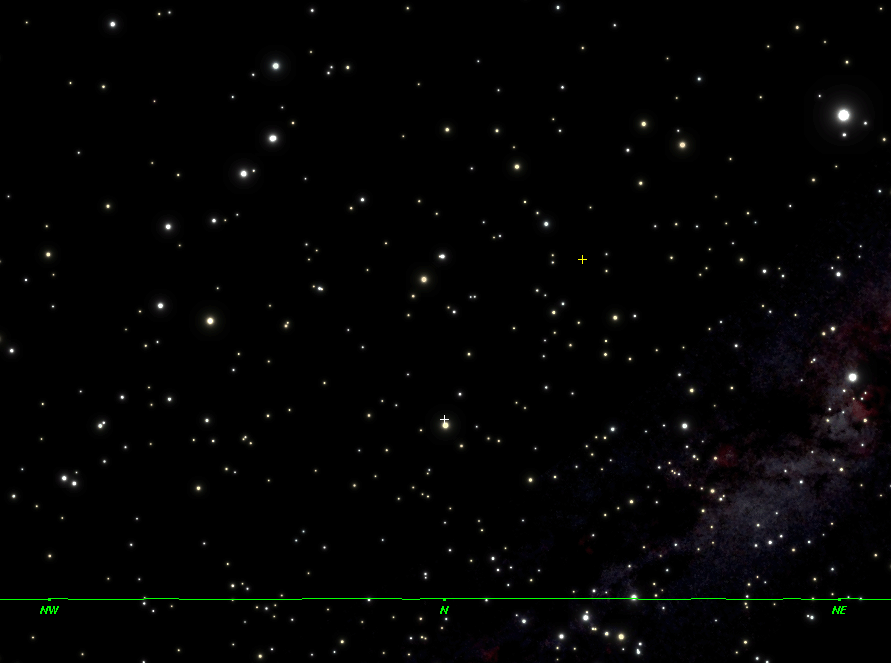
8. Pira‘etea (Deneb) (20h 41.4m) and Gienah (20h 46.2m). Over five hours after Pherkad and Ed Asich cross the meridian, the next pair arrives: Pira‘etea (Deneb) and Gienah, both in the constellation Cygnus, the Swan. (Deneb, the brighter of the two is the tail, Gienah the right wing-tip, near the top of the chart).
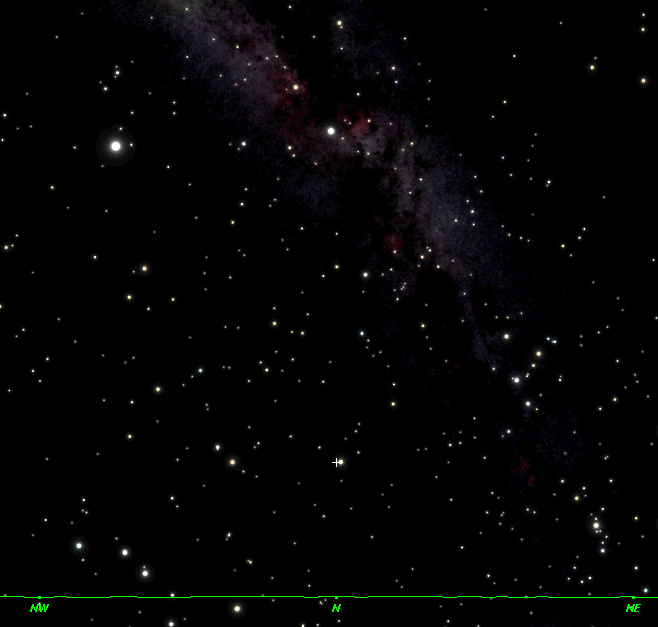
Keoe (Vega) is to the left of Pira‘etea (Deneb); below it, Na Hiku (the Dipper, is setting at NNW. Keoe (Vega), the brightest star in the chart, is to the left of Pira‘etea (Deneb). Below it Na Hiku (Big Dipper) is setting, its cup marking NNW. ‘Iwakeli‘i has flown higher than the NCP, to the east, or right.
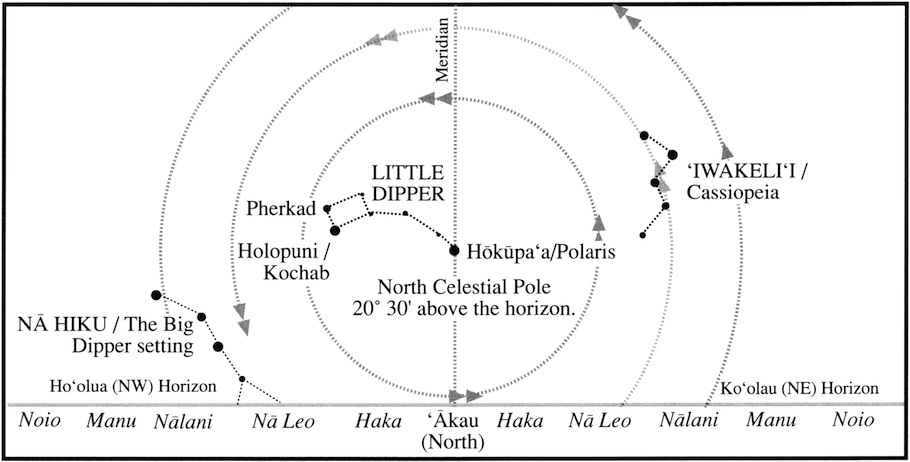
9. Scheat (23h 3.8m) and Markab (23h 2.8m). Over two hours after Pira‘etea (Deneb) and Gienah cross the meridian, the front two stars of Ka Lupe o Kawelo (Great Square), Scheat and Markab, are aligned above the NCP and N. To the right of these two pointers are Alpheratz, the brightest of the four stars in the Great Square of Pegasus, and above it, Algenib. [The “square” looks less square in the chart than in reality because of the distortion creation by spreading out the three-dimensional celestial sphere onto a two-dimensional chart. A distance at the top of the chart is wider than the same distance at the bottom of the chart, with the distortion greater at the top of the chart.]

At the lower right side of the chart, the bright star Hokulei (Capella) appears above the horizon, having risen on the border of NE and NE by N earlier.
